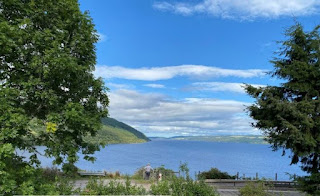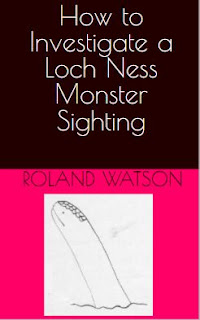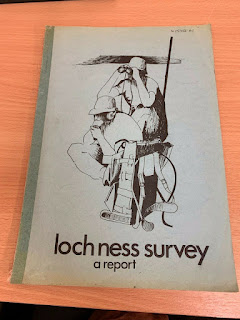Joe Zarzynski, seasoned hunter of the monsters of Lake Champlain and Loch Ness has published his autobiography and I review it here. I pre-ordered this in mid-December when it was announced, but it took until a couple of weeks ago before it finally arrived. As the title suggests, it is a biography that spans two worlds, running and hunting. The running refers to Joe's love for marathons and the other was his second love of cryptid hunting.
To be more specific, Joe crafts his story around an ultra-marathon run he did from Fort Augustus to Lochend in 1984. An ultra-marathon is running a distance beyond the 26 miles of the classic marathon. Before that, Joe tells us how he got into the two pursuits around the same time and how they grew together as he ran marathons into the 1980s with his interest in cryptozoology beginning in the mid 1970s and developed into expeditions at Loch Ness and his more local Lake Champlain for at least another ten years.
Joe got to Loch Ness in 1975 and thus began a series of trips as he tells us about the various characters we have got to know about through other books, videos and so on. The list includes Gregory Brussey, Alex Campbell, Tim Dinsdale, Robert Rines, Roy Mackal, Adrian Shine, Winifred Cary (whom I mentioned in my last article) and others.
We are regaled with tales of Joe working with these people and their projects and some helping him at Lake Champlain. Add to this his trips to other lochs reputed to have monsters and we have an enjoyable mosaic of tales to read. Indeed, the chapters recounting the monster and people landmarks along his marathon run of 1984 are also informative and entertaining. Indeed, Joe may be the only person to have seen both Nessie and Champ!
Joe eventually moved into marine archaeology but never lost his belief in cryptids or the taste for the hunt. His later interest in underwater wrecks was preceded by his sonar and scuba searches which gives us interesting insights into the sunken Wellington bomber of Loch Ness, Marty Klein's stone artifacts and the Loch Ness Monster prop lost in the loch around 1969.
Now I am no fan of marathon running or athletics in general. I only ever really took an interest in the 100m and 200m sprints and watching the likes of Alan Wells, Carl Lewis and Usain Bolt. One thing that did chime was Joe's 1984 Loch Ness run and his encounter with the cars and lorries racing down the road. Joe tells how he had to dodge these vehicles as he ran.
I can totally concur as I once had to walk from a parking layby to a spot of interest a couple of miles down the A82 and just opposite Foyers. That was not an easy trip as I had to keep a keen eye out for approaching vehicles and moving quickly to the safest spot. That may have been jumping over a wall into the bush and grass or just stepping into the ditch as there was nothing resembling a path. The things you do in the name of research.
So runs the story of Joe Zarzynski, marathon running and Loch Ness. Joe speculated that he may have been the first person to run a marathon along Loch Ness. He may well have been, it was not something I would know of, but I thought I would check the newspaper archives for any predecessors. Admittedly, most long distance athletes were of the aquatic variety as various people have swam the length of the loch. There was even a diver who walked along Loch Ness underwater!
However, there may have been at least one person who ran the length of Loch Ness back in February 1960. At that time, the owner of the Butlin holiday resorts had put up a £5,000 prize for a national walk from John O' Groats to Lands End. The News Chronicle for 29th February gives an update on the competition:
Late last night Robinson and John Grundy, from Wakefield, Yorks, were both at Fort Augustus. 19 miles farther along the loch. about 150 miles from the start Robinson arrived at 8:50. after covering the last 42 miles in 11 hours 40 minutes; Grundy, a marathon runner. who runs all the way, arrived at 8:12 after taking 8 hours. 20 minutes for the same stretch. Robinson. who lives at Maidenhead, Berks, was a member of the Oxford University cross-country team in 1953.
So it appears a John Grundy ran 42 miles from Dingwall to Fort Augustus 24 years before Joe, though it surprised me he was allowed to run and not walk. Well, you could argue it wasn't a marathon along Loch Ness, I will leave others to define what constitutes a marathon run.
The book is accurate and balanced throughout, the only error of note that I saw was that he placed the fake Marmaduke Wetherell hippo prints at Dores, when it was actually further south near Foyers. It is apparent Joe still believes in the likelihood of large creatures in Loch Ness and Lake Champlain and I would like to have read more about what he classes as the best sightings, photos, etc from his perspective as a seasoned monster hunter. I guess that includes such items as the Mansi photograph.
All in all, a book I recommend to Nessie and Champ lovers.
Comments can also be made at the Loch Ness Mystery Blog Facebook group.
The author can be contacted at lochnesskelpie@gmail.com






















